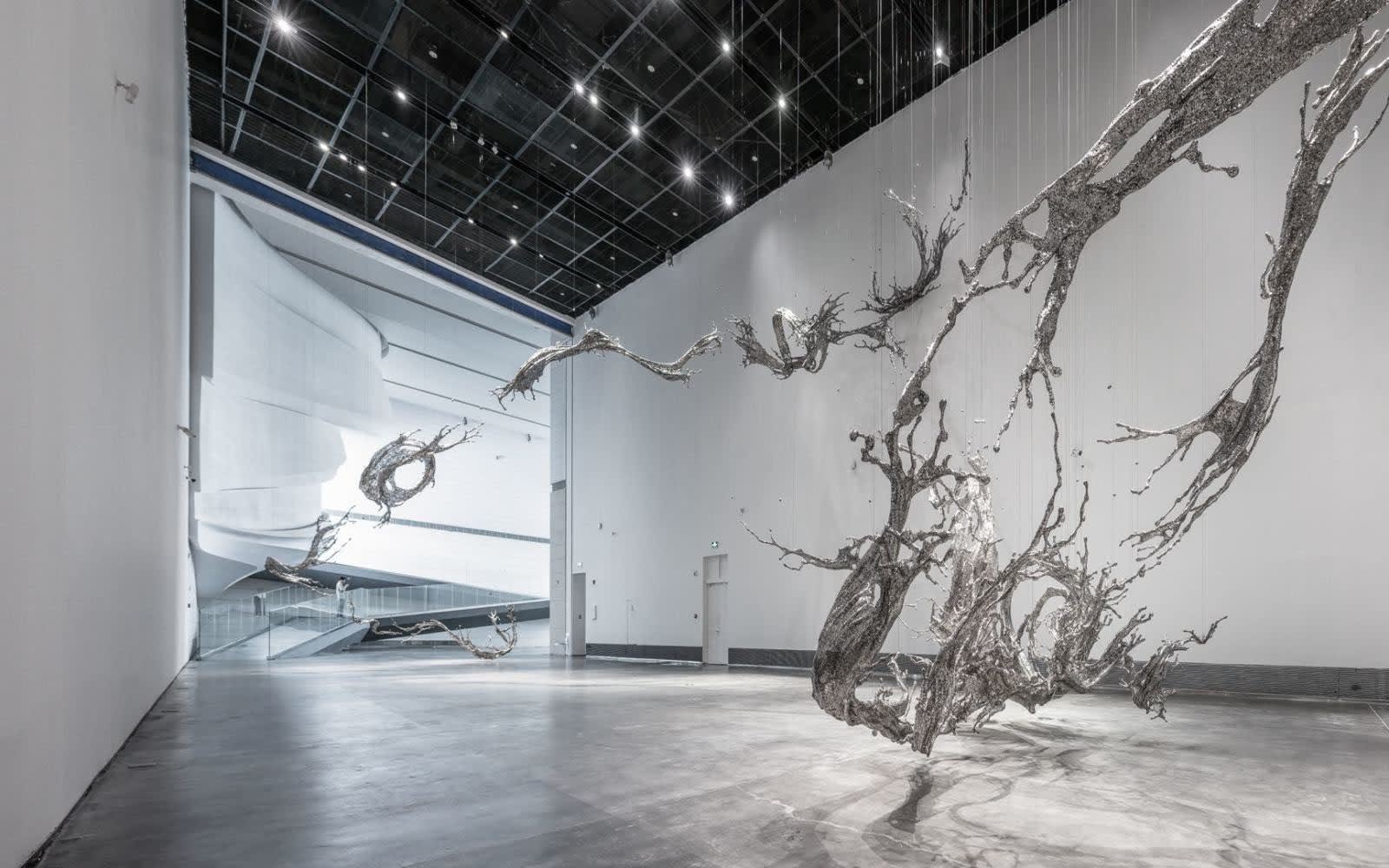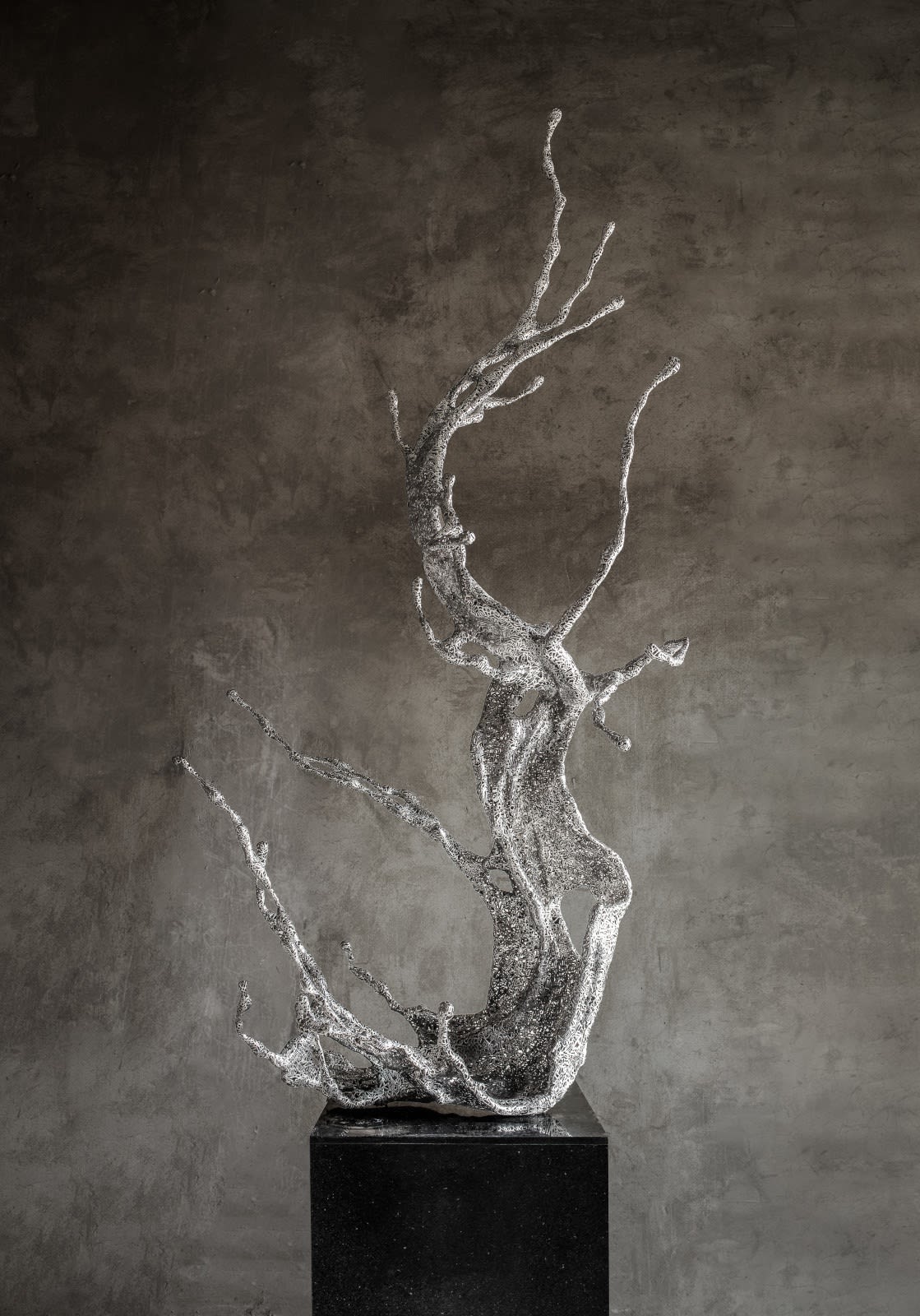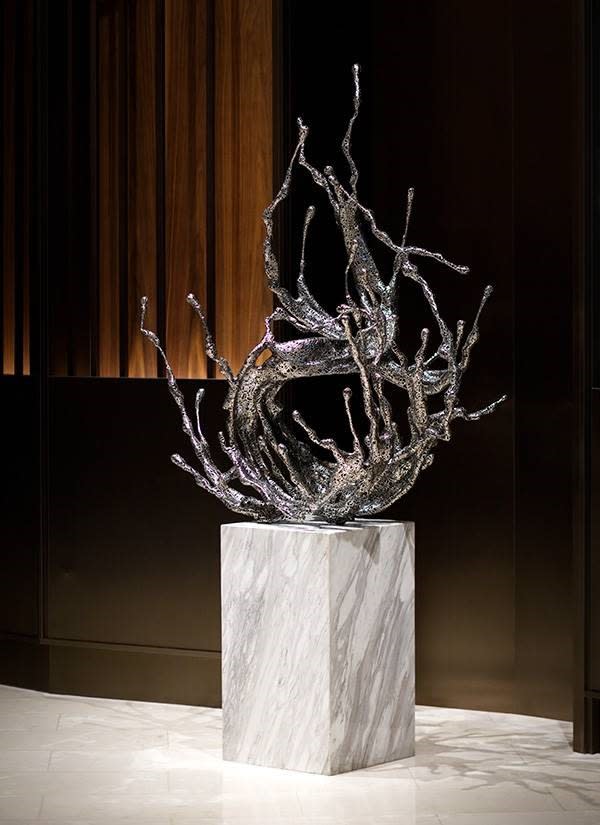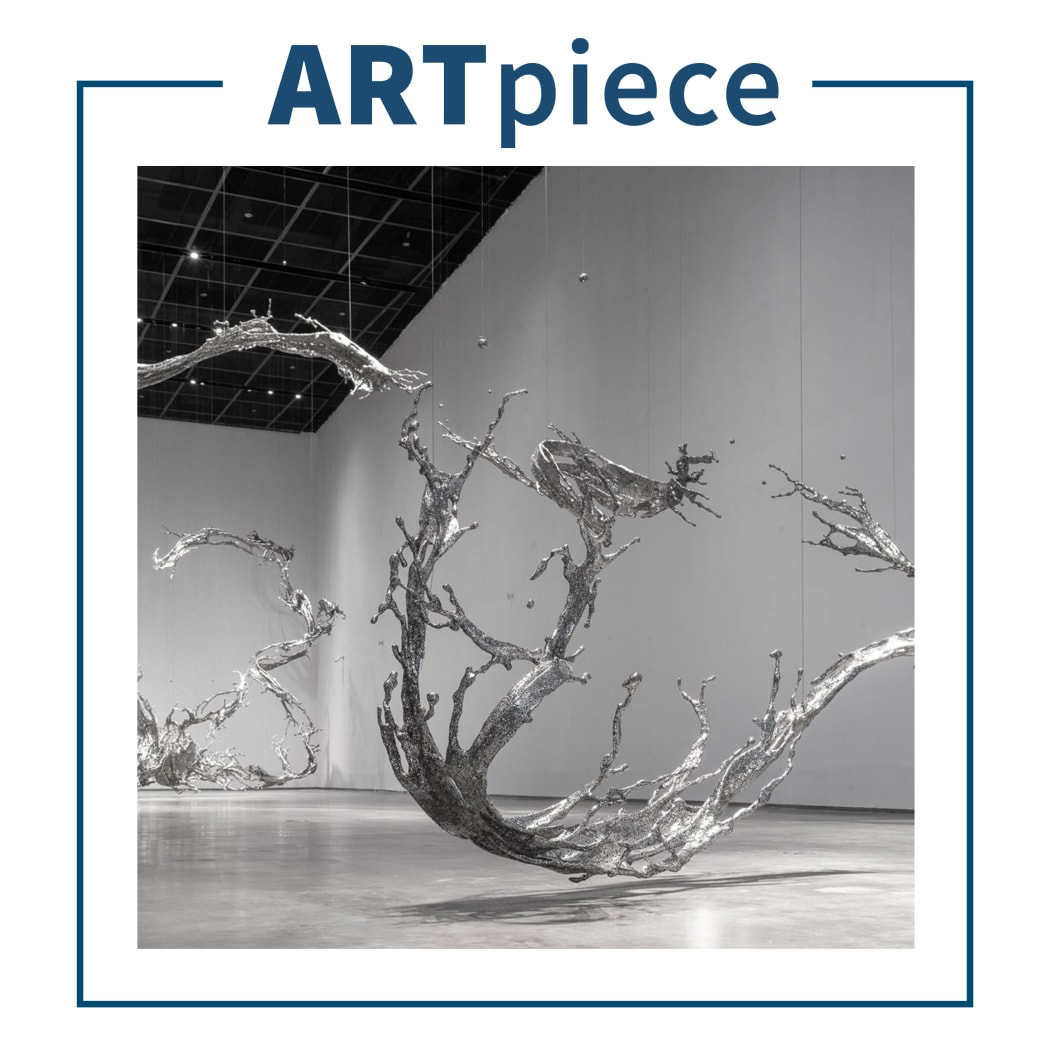
In the biweekly series ARTpiece, we are highlighting one artwork from 3812 Gallery's collection, to inspire you to add it to yours.
This week, we have chosen Zheng Lu's gravity-defying sculpture series Water in Dripping, inspired by Chinese calligraphy, a beautiful example of Eastern Origin and Contemporary Expression. Huang Du shares with us his study of Zheng's work in his essay On the Form and Formlessness of Water.
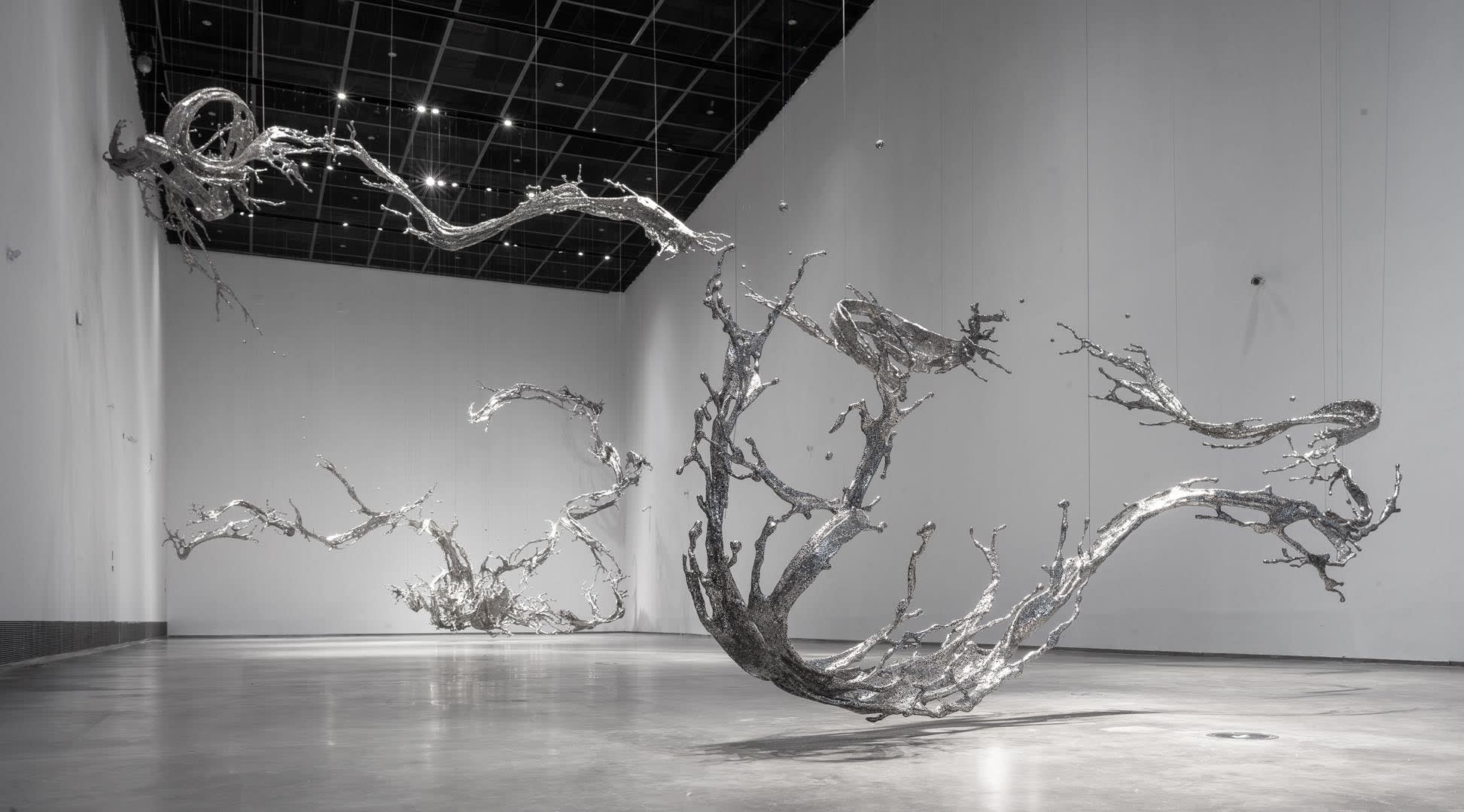
Zheng Lu, Water in Dripping - Silent Narratives, 2019 Stainless Steel, Site-installation, Variable size Exhibited in Yinchuan Museum of Contemporary Art, Ningxia, China
Zheng Lu's "dripping" series began in 2008. These gravity-defying sculptures take stainless steel characters of Chinese calligraphy as elements to form a static sculptural representation of water in motion. This is an important series that Zheng Lu has created following his lifelong study of traditional Chinese culture.
The Water in Dripping series focuses on the interaction and conflict between sculpture and writing. The text of Tang dynasty poet Bai Juyi's poem Appreciating Still Water is integrated into Zheng's sculptures in the form of the calligraphic characters, and was the source of inspiration for this series. The sculptures take writing as a tool for expression, but the series also transcends the meaning and connotation of the text itself. Bai Juyi's Appreciating Still Water reflects on the dynamic and static changes of water, but ultimately refers to human reason.
Those in motion enjoy flowing water;
Those who are tranquil enjoy still water.
No object is as sharp as flowing water;
No mirror as reflective as still water.
Its calmness does not differ from Chan contemplation;
Its brightness resembles one's sincerity.
- Appreciating Still Water (extract), Bai Juyi
Zheng Lu, Water in Dripping - Silent Narratives, 2019
Stainless Steel, Site-installation, Variable size
Exhibited in Yinchuan Museum of Contemporary Art, Ningxia, China
Just as this poem concisely describes the infinite imagination tied to the motion and stillness of water, Zheng Lu’s sculpture evokes this poetic realm through shape, capturing water in a fully dynamic state, and fixing that moment in stillness. The artwork has the traits of an installation sculpture. When hung in the exhibition space, the buoyant dynamism of water forms a sense of powerful tension with the orderly square space. This state of water produces a chain of conceptual linkage between motion and stillness, poetry and water, one marked with deep Chan and Daoist insight.
"The good is like water. Water benefits all things without contention, and collects in places others dislike. Thus, it is close to the Dao."
- Lao Tzu
Zheng Lu, Water in Dripping - Rippling, 2016
Stainless Steel, 80 cm x 190 cm x 80 cm
MGM Cotai Chairman's Collection
In Daoist thinking, water is the embodiment of goodness and softness. Water is continuous and unbroken, entirely silent at its ebb, and a rushing torrent at its height. It does not struggle with others, and can encompass all things. Water has the virtue to nurture all things, bringing benefit to all without coming into conflict with others. This is the highest aspiration for human life. That is why “the good is like water” shows us the spiritual import of this material thing. Here, the highest level of human character is equated with the qualities of water, benefiting all things without contending for fame or fortune, occupying the overlooked or unseen places. That is why it is the closest to the Dao. Water is tasteless and odourless. It exists in many different states in nature, never violating its ways.

Zheng Lu, Water in Dripping - Floating, 2016
Stainless Steel, 90 cm x 125 cm x 75 cm
MGM Cotai Chairman's Collection
When confronting the sociocultural import of water, Zheng Lu began to ponder how to convey the visual significance of water’s formlessness and form in sculpture. He has grasped water’s transparent properties and lack of fixed form, while also becoming fluent in the cultural symbolism often affixed to it. In Water in Dripping-Waves, the artist did not choose the continuous, tranquil state of water but instead conveyed a moment of leaping, surging waves, giving vivid expression to the dynamic splashing of water. He deftly fused the poeticism of water into sculpture.

Zheng Lu, Water in Dripping - Rippling, 2016
Stainless Steel, 80 cm x 190 cm x 80 cm
MGM Cotai Chairman's Collection
American conceptual artist Lawrence Weiner is also well known for his use of words in his creations. Unlike Weiner’s insistence that the word is itself a sculpture (he uses common fonts to arrange words together with images whose connection is often difficult to understand, sometimes accompanied with a poetic phrase that is at once clear and obscure; he often transforms linguistic signs into the foundation of his creations, and words as the main carrier of his creative ideas as he raises doubts about the essence of traditional notions of artistic creation), Zheng Lu focuses on the relationship between the shape of the sculpture and the narrative of the words, using metal sculpture hollowed out to reveal elegant dynamic curves formed by poetry, treating the words as a spiritual carrier of the sculpture creation as well as a formative element of the sculpture itself. In this way, the words not only transcend their function as a medium for reading, they also strengthen the decorative nature of the formal language of sculpture, forming a unique art form where flowing formal lines and romantic poeticism intertwine.
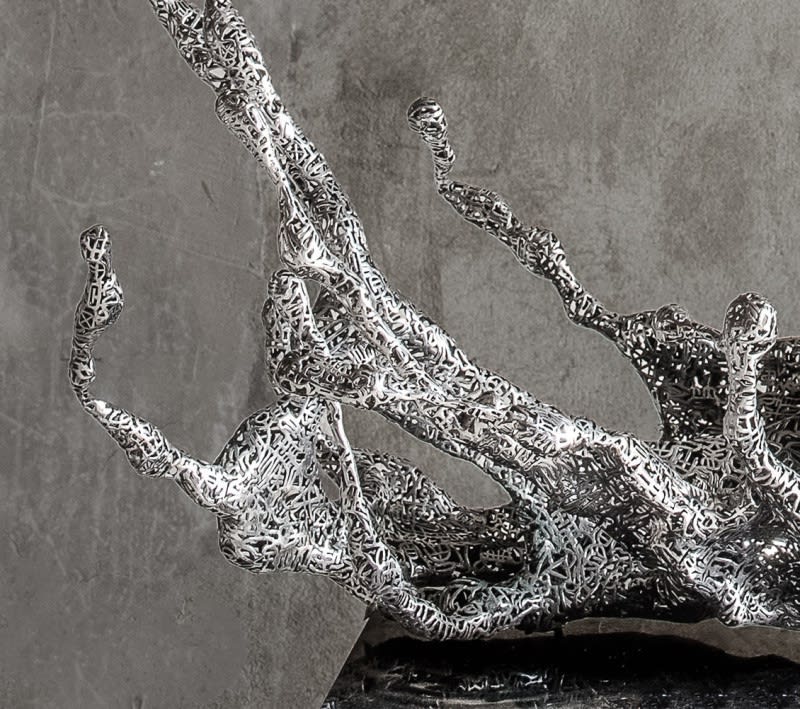

Details of Water in Dripping - Rippling (top) and Water in Dripping - Floating (bottom)
For artist Zheng Lu, water is a system of traits: tasteless and odourless, fluid and changing, sometimes gentle, sometimes surging with energy, subject to outside forces that can make it soft and delicate, or explode with energy. Whether the water is moving or still, Zheng Lu uses decontextualizing methods to transform this medium from a narration of content to pure form. As a result, when it is presented to the audience as a visual image, it inevitably gives rise to different associations and ideas. In this sense, the image of water is not purely formal visual beauty; it also encompasses related social meaning. That is to say, it is at once seen as a spirit of freedom and as a metaphor for relationships in state and society. In discussing the relationship between rulers and their people, Warring States period thinker Xun Kuang likened the people to river water, stating, “The ruler is a boat, the common people the water. The water can lift the boat, as well as capsize it.” This metaphor has much philosophical import for society. The people, the water, have the power to carry the ruler, as well as to drown him.
Zheng Lu, Water in Dripping - Floating, 2016
Stainless Steel, 90 cm x 125 cm x 75 cm
MGM Cotai Chairman's Collection
We could say that the young artist Zheng Lu is already keenly aware that in an artist’s individual practice, he must establish his own system of artistic logic and language. He is well aware of the necessity of skill in sculpting, and fluent in the meticulous crafting process of metals required to turn them into exquisite carriers of symbolic meaning. He has folded the elements of hollowness, words, water, animals and space into a self-contained conceptual framework that forms a unique language for expression. We catch glimpses of this in his recent works, where he has interpreted the myriad forms of water from multiple angles. Drawing from the softness of water to allude to the infinite potential forms of life and thus illuminate ways of dealing with individual development within the social environment, as well as how to deal with the relationship between nature, self-nature and the self. He uses water as an allegorical body, striving to reach accord between form and content and create a poetic vision. With contemporary language, he has bestowed water with the beauty of vastness and emptiness, making his works a rich embodiment of history and reality, tradition and modernity, visible and invisible, poetry and vision, life and symbol.
